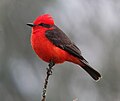| Pyrocephalus | |
|---|---|
 | |
| Scarlet flycatcher (Pyrocephalus rubinus) | |
| Scientific classification | |
| Kingdom: | Animalia |
| Phylum: | Chordata |
| Class: | Aves |
| Order: | Passeriformes |
| Family: | Tyrannidae |
| Genus: | Pyrocephalus Gould, 1838 |
| Type species | |
| Muscicapa coronata [1] Gmelin, 1789 | |
| Species | |
See text | |
Pyrocephalus is a genus of bird in the tyrant flycatcher family, Tyrannidae.
Contents
The genus was introduced by the English ornithologist and bird artist John Gould in 1839 in Charles Darwin's Zoology of the Voyage of H.M.S. Beagle . [2] [a] The type species was designated as the scarlet flycatcher (Pyrocephalus rubinus) by the English zoologist George Robert Gray in 1840. [6] [7] The name Pyrocephalus combines the Ancient Greek purrhos meaning "flame-coloured" or "red" and -kephalos meaning "-headed". [8]



